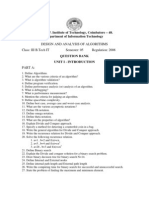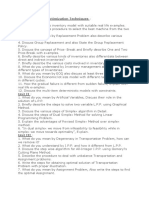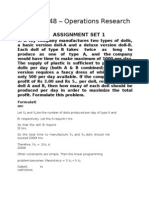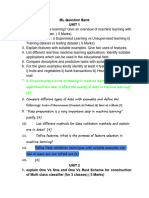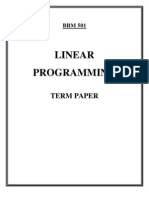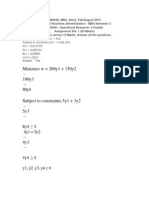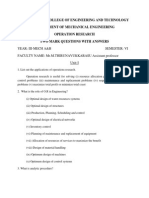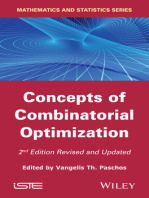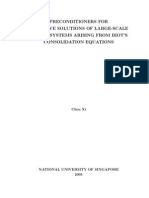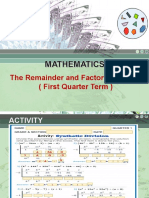Optimization Techniques
Uploaded by
abhinandanpaul1Optimization Techniques
Uploaded by
abhinandanpaul1Model Questions for the Course Optimization Techniques
Unit-1
1. Define the criteria for a function to be continuous. Explain with suitable examples.
2. Define vector and explain the concept of addition of two vectors.
3. Prove that a + b = b + a in vector calculus, where a and b are two vectors.
4. Explain how to calculate b - a in vector calculus, where a and b are two vectors.
5. Write a short note on Eigen value and give any one application of Eigen value.
6. Define the term optimization problem. Give two examples.
7. Write a short note on the complexity of algorithms.
8. Calculate Big-Oh notation for the following function 5 x2 – 2x + 3
9. What is the need to calculate the time complexity?
10. What is the advantage of theta-notation over Big-Oh notation?
Unit-2
1. Define the term “feasibility” with the help of suitable examples.
2. What is meant by the unbounded solution?
3. Explain the following terms with the help of a suitable example: (i) optimal solution (ii)
constraints (iii) decision variable.
4. What is meant by constraints? Which are the different types of constraints?
5. What are the problems associated with using gradient based method to solve optimization
problems?
6. Explain how to identify three types of local extrema using gradient.
7. Explain the term local optima with the help of a suitable example.
8. Write a short note on any gradient free method to solve optimization problems.
9. Write a short note on BFGS method.
10. Demonstrate the use of slack variable.
11. What is the standard form of a linear programming problem?
12. Explain Nelder-Mead algorithm.
13. Use Nelder-Mead algorithms to minimize f(x) = x2 – 4x + y2 - xy (Show upto 3 iterations).
Unit-3
1. What is meant by integer programming problem? Give a suitable example.
2. Justify why integer linear programming model is suitable for the following problem of
capital-budgeting: “Select the potential investments by choosing among the possible plant
locations and to settle upon a set of research and development projects. The objective is to
maximize total contributions from all the investments without exceeding the limited
availability of certain resources.”
3. What is meant by LP relaxation? What are the advantages of solving the LP relaxation
problem?
4. What are the properties of the LR problem with reference the corresponding IP.
5. Can rounding the solution of LP relaxed problem be a solution to integer LPP? Justify your
answer.
6. Define term over-fitting in the context of regression.
7. Explain how to detect and avoid over-fitting.
8. What is the need for lasso regression?
9. Define logistic regression. Explain a suitable problem where logistic regression could be
applied.
10. Write a short note on principal component analysis.
11. Use the simplex method to solve the following LP problem. (Solve upto 3 iterations)
Maximize Z = 3x1 + 5x2 + 4x3
subject to the constraints
(i) 2x1 + 3x2 ≤ 8, (ii) 2x2 + 5x3 ≤ 10, (iii) 3x1 + 2x2 + 4x3 ≤ 15 and x1, x2, x3 ≥ 0
Unit-4
1. Write a short note on support vector machine.
2. Explain deep learning with some application areas.
3. Write any two applications of queuing theory.
4. Explain the arrival process in queuing model.
5. What are the queue characteristics?
6. State and explain Little’s Law.
7. John owns a small coffee shop. He wants to know the average number of customers queuing
in his coffee shop, to decide whether he needs to add more space to accommodate more
customers. Currently, his queuing area can accommodate no more than eight people. John
measured that, on average, 40 customers arrive at his coffee shop every hour. He also
determined that, on average, a customer spends around 6 minutes in his store (or 0.1
hours). Given these inputs, find the average number of customers queuing in his coffee
shop.
8. In a conference lunch, if each participant needs about 45 seconds to take his/her food and
there are 1000 participants, how many tables should be provided (assume two sides of the
serving tables could be used) so that the lunch break can be finished within one hour?
9. What is meant by multi-objective optimization? Name any one method to solve these type
of problems.
10. Explain Pareto optimality with the help of suitable diagrams and/or examples.
Unit-5
1. Explain the method to convert constrained optimization to unconstrained one. Give a
suitable example.
2. What is the use of penalty functions?
3. Convert into unconstrained form by explaining the steps followed: minimize f(x) = 100/x
subject to x ≤ 5
4. Explain the term quadratic loss based on the constraint x ≤ 5.
5. Explain how to calculate quadratic loss for equality constraints and inequality constraints.
6. Justify the need to multiply the quadratic loss function by a constant while framing the
objective function.
7. Explain the term simulated annealing.
8. Explain the general framework of particle swarm optimization.
9. Write the PSO algorithm and explain its working.
10. Compare genetic algorithm and PSO.
11. Explain fire-fly algorithm.
12. What are the advantages of evolutionary algorithms over gradient based algorithms in
solving optimization problems?
You might also like
- Computational Method For Numerical Analysis With RNo ratings yetComputational Method For Numerical Analysis With R13 pages
- 5153 DESIGN and ANALYSIS of ALGORITHMS Anna University Previous Year Question Paper100% (1)5153 DESIGN and ANALYSIS of ALGORITHMS Anna University Previous Year Question Paper6 pages
- Cs6402-Design and Analysis of Algorithm Question Bank Unit-INo ratings yetCs6402-Design and Analysis of Algorithm Question Bank Unit-I12 pages
- Daa-2marks and 10 Marksdescriptive Questions100% (1)Daa-2marks and 10 Marksdescriptive Questions3 pages
- DAA-important Questions For External ExamNo ratings yetDAA-important Questions For External Exam3 pages
- Question Bank Module-1: Department of Computer Applications 18mca53 - Machine LearningNo ratings yetQuestion Bank Module-1: Department of Computer Applications 18mca53 - Machine Learning7 pages
- Important Questions Unitwise - DAA and IOTNo ratings yetImportant Questions Unitwise - DAA and IOT18 pages
- Subject: Algorithm Analysis and Design: Question BankNo ratings yetSubject: Algorithm Analysis and Design: Question Bank10 pages
- Advanced Computational Methodology Updated Question BankNo ratings yetAdvanced Computational Methodology Updated Question Bank5 pages
- MB0048 - Operations Research: Assignment Set 1100% (1)MB0048 - Operations Research: Assignment Set 124 pages
- Operations Research) 04BB1501: Bba/Bba (H)No ratings yetOperations Research) 04BB1501: Bba/Bba (H)7 pages
- Samples Questions For Blooms Taxonomy LevelsNo ratings yetSamples Questions For Blooms Taxonomy Levels7 pages
- Tutorial 5: FIT 1029 - Algorithmic Problem SolvingNo ratings yetTutorial 5: FIT 1029 - Algorithmic Problem Solving2 pages
- Register No. Time: 3 Hours Maximum Marks: 100No ratings yetRegister No. Time: 3 Hours Maximum Marks: 1002 pages
- 621 Finalexam Semii 2004 05 Distributed SystemsNo ratings yet621 Finalexam Semii 2004 05 Distributed Systems11 pages
- PPT4 - W3-S4 - Integer Programming - R0No ratings yetPPT4 - W3-S4 - Integer Programming - R041 pages
- OPERATION RESEARCH 2 Mark Questions With Answers82% (11)OPERATION RESEARCH 2 Mark Questions With Answers19 pages
- OPERATION RESEARCH 2 Mark Questions With Answers91% (55)OPERATION RESEARCH 2 Mark Questions With Answers11 pages
- Preconditioners For Iterative Solutions of Large-Sclae Linear Systems Arising From Biots Consolidation EquationsNo ratings yetPreconditioners For Iterative Solutions of Large-Sclae Linear Systems Arising From Biots Consolidation Equations258 pages
- Algorithms-I CSC 302 (July-Dec2022 IIITK) L41 - L42No ratings yetAlgorithms-I CSC 302 (July-Dec2022 IIITK) L41 - L4269 pages
- A Branch-And-Cut-And-Price Algorithm For One-Dimensional Stock Cutting and Two-Dimensional Two-Stage Cutting G. Belov, G. ScheithauerNo ratings yetA Branch-And-Cut-And-Price Algorithm For One-Dimensional Stock Cutting and Two-Dimensional Two-Stage Cutting G. Belov, G. Scheithauer22 pages
- Haramaya University: College of Business and EconomicsNo ratings yetHaramaya University: College of Business and Economics48 pages
- A Primal-Dual Method For Solving Linear PDFNo ratings yetA Primal-Dual Method For Solving Linear PDF22 pages
- Instant Download Numerical Methods and Optimization An Introduction 1st Edition Pardalos PDF All Chapters100% (3)Instant Download Numerical Methods and Optimization An Introduction 1st Edition Pardalos PDF All Chapters81 pages
- Flow Chart of Bisection Method: Start: Given a,b and ε u = f (a) ; v = f (b) c = (a+b) /2 ; w = f (c) yes no noNo ratings yetFlow Chart of Bisection Method: Start: Given a,b and ε u = f (a) ; v = f (b) c = (a+b) /2 ; w = f (c) yes no no10 pages
- Algorithm W Step by Step: Martin Grabm UllerNo ratings yetAlgorithm W Step by Step: Martin Grabm Uller7 pages
- Module 8 - Linear Inequalities & LPP - CETNo ratings yetModule 8 - Linear Inequalities & LPP - CET20 pages
- Introduction To Singular Perturbation Theory: Erika MayNo ratings yetIntroduction To Singular Perturbation Theory: Erika May24 pages



